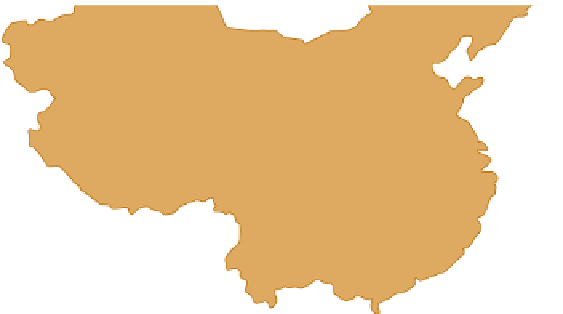Geoscience Reference
In-Depth Information
(a)
Figure 15.13 Sinkhole topography.
(a) Sometimes sinkholes
develop that extend below the depth of the water table, form-
ing ponds. (b) Sinkholes show up clearly on topographic maps
as ponds, where they are filled with water, and as depressions,
where contour lines make concentric circles.
(b)
sinkholes and various other collapse structures form. If enough
of these karst features exist, the effect is to produce a number of
towering hills that are the unaffected remnants of the block of
solid limestone that once existed. Streams also play a role in the
development of tower karst because they cut steep valleys into
the regional rock mass.
An excellent place to see fantastic tower karst is in
southeastern China (Figure 15.14), near the city of Guilin in
the northern part of Guangxi province. This area lies within
the humid subtropical climate region and is affected by the
southeastern monsoon. The Guilin area is covered by carbon-
ate rocks that may reach a thickness of 4600 m (~15,000 ft).
Two major surface karst landforms occur in the region: (1) the
peak-cluster depressions (Fengcong) and (2) the peak-forest
plain (Fenglin). These areas collectively cover an area 2429
km
2
(938 mi
2
) in size. The Fengcong landscape consists of a
group of peaks separated from each other by collapse depres-
sions, whereas the Fenglin areas are a group of isolated peaks
separated by flat ground created by streams. Taken together,
these hills literally tower over the landscape, reaching heights
of 200 m (660 ft) above the surrounding lowlands and giving
the region a beautifully surreal quality. Close to the mainland
United States, the only place to see tower karst is the northern
part of Puerto Rico.
75
°
E
90
°
E
105
°
E
120
°
E
Beijing
China
30
°
N
Guilin
0
250
500 km
0
250
500 mi
Guangxi
South
China
Sea
(a)
Bay of
Bengal
15
°
N
Figure 15.14 Tower karst in China.
(a) This surreal land-
scape of isolated peaks near Guilin, China, formed when thick
limestones were dissolved and collapse structures formed on a
massive scale. (b) The Guangxi province in southeastern China is
especially known for its tower karst.
(b)















